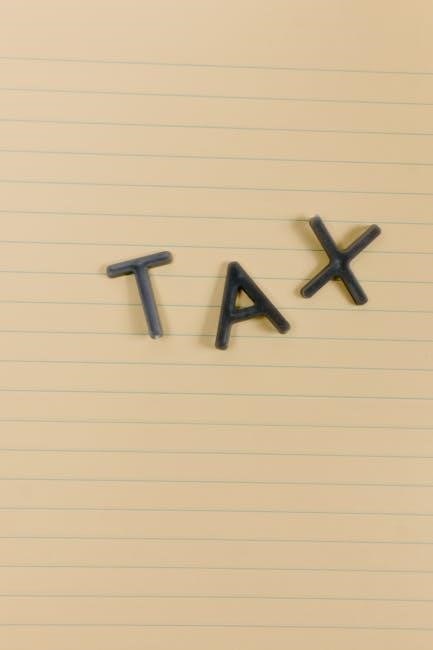Understanding the Home Office Deduction for Home-Based Businesses
The home office deduction allows eligible taxpayers to deduct expenses for business use of their home, such as utilities, insurance, and depreciation, following IRS guidelines and requirements.
What Qualifies as a Home Office?
A home office qualifies if it is used regularly and exclusively for business purposes. It can be a dedicated room, a portion of a room, or even a separate structure on the property. The space must be the primary location for conducting business activities, such as meetings with clients or managing operations. To meet IRS criteria, the area must not be used for personal activities, ensuring it remains solely for business use. This qualification is essential for claiming deductions on IRS Form 8829 and adhering to tax guidelines outlined in Publication 587.

Calculating the Home Office Deduction Using IRS Guidelines
To calculate the home office deduction, taxpayers can use one of two IRS-approved methods: the Simplified Option or the Regular Method. The Simplified Option allows a deduction of $5 per square foot of home office space, up to $1,500. The Regular Method requires calculating actual expenses, such as mortgage interest, property taxes, utilities, and depreciation, and applying the business use percentage. Choose the method that best fits your situation for accurate tax savings.
IRS Form 8829: Expenses for Business Use of Your Home
IRS Form 8829 helps self-employed individuals and business owners calculate deductible home office expenses, including utilities, insurance, and depreciation, for tax purposes.
How to Complete Form 8829 for Home-Based Businesses
To complete IRS Form 8829, calculate business use percentage, list home expenses, and deduct allowable amounts. Attach to Schedule C for accurate tax filing.
Importance of Accurate Record-Keeping for Form 8829
Accurate record-keeping is essential for completing Form 8829, as it ensures compliance with IRS guidelines and supports deductible expenses. Maintain detailed records of utility bills, insurance, mortgage interest, and depreciation. Proper documentation helps prevent audits and ensures accurate calculation of business use percentages. Keep organized files for at least three years to substantiate claims and demonstrate adherence to IRS requirements for home-based businesses.
Carryover of Unused Deductions to Future Tax Years
If the total home office deduction exceeds annual business income, the unused portion can be carried forward to future tax years. This ensures no loss of benefits, allowing businesses to claim deductions when income increases. Proper documentation and adherence to IRS guidelines are crucial for carryover eligibility, ensuring compliance and maximizing future tax savings.
Publication 587: Business Use of Your Home
Publication 587 guides taxpayers on deducting expenses for business use of a home, including rules for calculating deductions and special cases like daycare providers.
Overview of Publication 587 and Its Relevance to Home-Based Businesses
Publication 587 provides detailed guidance for taxpayers on deducting expenses related to the business use of a home. It outlines eligibility criteria, deductible expenses, and calculation methods. The publication is essential for home-based businesses, offering clear instructions on how to properly claim deductions. It covers topics such as mortgage interest, utilities, and depreciation, ensuring accurate tax filings. Special rules for daycare providers and other unique cases are also addressed, making it a comprehensive resource for understanding home-based business tax deductions.
Special Rules for Daycare Providers and Other Unique Cases
Daycare providers and certain unique businesses face specific IRS rules for home office deductions. Publication 587 highlights that daycare providers can deduct expenses based on the time and space used for their services. These deductions may include a portion of utilities, rent, and other related costs. Additionally, the IRS offers flexibility for businesses with non-traditional spaces or shared usage, ensuring accurate and fair deductions. Proper documentation and adherence to guidelines are crucial to avoid audits and ensure compliance with tax regulations.

Mortgage Interest and Property Taxes as Deductible Expenses
Mortgage interest and property taxes are deductible expenses for home-based businesses, calculated based on the business use percentage of the home, providing significant tax savings.
How to Deduct Mortgage Interest for Business Use of Your Home
To deduct mortgage interest for business use, calculate the business use percentage of your home. Report this on IRS Form 8829, then apply the percentage to your total mortgage interest. This amount is deductible on Schedule C. Ensure accurate records, including mortgage statements and business use calculations, to support your deduction. This step is crucial for maximizing tax savings and complying with IRS requirements for home-based businesses.
Property Taxes and Their Impact on Home-Based Business Deductions
Property taxes are partially deductible for home-based businesses based on the business use percentage. Calculate this percentage using Form 8829, then apply it to your total property taxes. Deduct the result on Schedule C. Keep records of tax payments and business use calculations to support your claim. Accurate documentation ensures compliance and maximizes deductions, aligning with IRS guidelines for home office expenses as outlined in Publication 587 and related resources.

Utilities and Insurance for Home-Based Businesses
Utilities and insurance expenses for home-based businesses are partially deductible based on the business use percentage, supporting tax savings when properly documented and calculated according to IRS guidelines.
Calculating Deductible Utility Expenses
To calculate deductible utility expenses for a home-based business, determine the business use percentage of your home using IRS Form 8829. Multiply total utility costs by this percentage to find the deductible amount. For example, if your business uses 30% of your home, 30% of annual utility bills can be deducted. Accurate records of utility bills and business use calculations are essential to support deductions and ensure compliance with IRS guidelines, maximizing tax savings for home-based businesses.
Insurance Premiums and Their Eligibility for Tax Deductions
Insurance premiums for your home can be partially deducted if the property is used for business. The deductible amount is based on the business use percentage of your home, calculated using IRS Form 8829. For example, if 30% of your home is dedicated to business, 30% of your insurance premiums may be deductible. Accurate records of premiums and business use are essential to support this deduction. This applies to both homeowners and renters, ensuring compliance with IRS guidelines and maximizing tax benefits for home-based businesses.
Depreciation of Home Assets for Business Use
Depreciation allows home-based businesses to deduct the cost of home assets over time. It applies to the business-use percentage of your home and ends when sold.
Understanding Depreciation and Its Application to Home-Based Businesses
Depreciation is a tax deduction method that allows home-based businesses to recover the cost of assets over their useful life. For home offices, depreciation applies to the business-use percentage of the home’s structural components, such as walls, windows, and doors. It does not apply to movable items like furniture. The IRS provides guidelines for calculating depreciation, often using the Modified Accelerated Cost Recovery System (MACRS). When the home is sold, any depreciation claimed may be subject to recapture, potentially increasing taxable income. Proper documentation is essential to ensure compliance and maximize deductions.
Depreciation Recapture and Its Tax Implications
Depreciation recapture is a tax rule requiring businesses to report and pay taxes on previously claimed depreciation deductions when an asset is sold. For home-based businesses, this applies if the home office is sold. The recaptured amount is taxed at ordinary income rates, up to 25% for real property. Any remaining profit may qualify as long-term capital gains. Proper documentation of depreciation and business use percentage is essential to accurately calculate recapture and minimize tax liability, ensuring compliance with IRS guidelines like those outlined in Form 8829 and Publication 587.

Maximizing Tax Deductions with the Business Use Percentage
The business use percentage determines the deductible portion of home expenses, calculated using IRS Form 8829. Accurate records ensure compliance and optimize tax savings for home-based businesses.
How to Calculate the Business Use Percentage of Your Home
To calculate the business use percentage, measure the total square footage of your home and the area used exclusively for business. Divide the business area by the total area and multiply by 100. Use Form 8829 to report expenses, ensuring accurate documentation like photos or floor plans. Regular and exclusive use is key, even for partial spaces. Depreciation may apply, and consulting IRS guidelines or a tax professional is advisable for compliance and accuracy.
Common Mistakes to Avoid When Determining Business Use Percentage
Common errors include failing to accurately measure and document business space, misclassifying areas as business use when they are not, and excluding personal-use spaces. Avoid using estimated percentages without proper calculation. Ensure only exclusive and regular business-use areas are included. Additionally, failing to maintain records like photos or floor plans can lead to disallowed deductions. Always consult IRS guidelines and consider professional advice to ensure compliance and avoid audit issues.